My Triumvirate of Mac Automation Technology
I have been an avid Mac and iOS automator for a little more than five years. It has, and continues to be, a positive influence on my personal and professional life, as well as a fun hobby.
However, it can be a tricky world to navigate for novices. Coincidently, I got interested in automation just as The Automators podcast was getting started, so it felt like I was being shepherded by the hosts. If you have the time and inclination, I encourage you to check it out from episode one.
In lieu of that, here is an overview of the Mac automation technology I use every day. There are plenty of other valid combinations and tools out there, but this set of tech is irreplaceable for me.
Keyboard Maestro
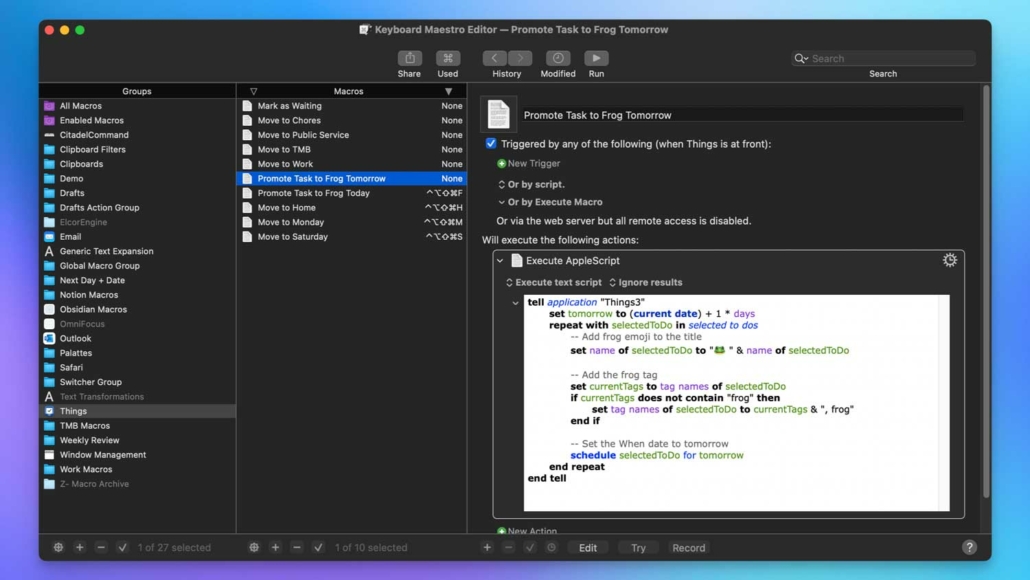
Second to writing your own code, I believe Keyboard Maestro is the most powerful automation tool on any OS. As with any tool that is very powerful and wide-ranging, it can be tough to understand where to start or even what it does.
Fortunately, there is a very active and supportive community over at the Keyboard Maestro Forum, including the developer of the app, who is a very helpful contributor to the community.
Use Case Examples
But before you join a forum or spend $36 on an app, you probably want an idea of what it does. In short, Keyboard Maestro can recognize a change in essentially any part of your Mac and can then make your Mac do pretty much anything in response. Here are a few examples:
- In any app, window, or text field (even online), if I misspell the word “appriciate” Keyboard Maestro will instantly delete my misspelled word and replace it with the correct spelling, “appreciate.”
- Similarly, anywhere I type “;cds” Keyboard Maestro will replace those four characters with the current date stamp in the format I prefer, “2024-01-08.”
- You can also restrict triggers to specific apps. I have “;lab” as a trigger only in Outlook. When I type ;lab in Outlook, it will create a custom email, address it to the person whose name is currently saved on my clipboard, and send the email.
But it is not just typing that gets recognized; there is a huge list of “triggers” that can begin automations. Here are a few more examples:
- If you connect to a wifi network that is not your home network, you can have Keyboard Maestro connect to your VPN.
- If you plug in a specific hard drive, you can have Keyboard Maestro create a zip file of certain folders and make a backup to the external hard drive.
- If a Word document gets added to a folder of your choice, you can have Keyboard Maestro convert it to a PDF and email it to someone.
- Every day at 4:30 am, I have Keyboard Maestro run an AppleScript to edit some daily tasks in Things.
More Resources to Help You Use Keyboard Maestro
If you want to see some more examples of how I personally use Keyboard Maestro, it is one of the most common subjects on my YouTube channel; you can find the Keyboard Maestro Playlist here. You can also find many blog posts on this site featuring Keyboard Maestro, specifically, this post about my time-saved stats might be interesting.
Who Should Use Keyboard Maestro
While I am tempted to say everyone, as you could download a few “macros” (essentially a file for Keyboard Maestro) created by others and use the tool effectively. The real magic comes when you learn to create your own solutions to your specifications. Because of that, I would say Keyboard Maestro is best for people who like to solve tech puzzles and who use a lot of native macOS apps.
Hazel
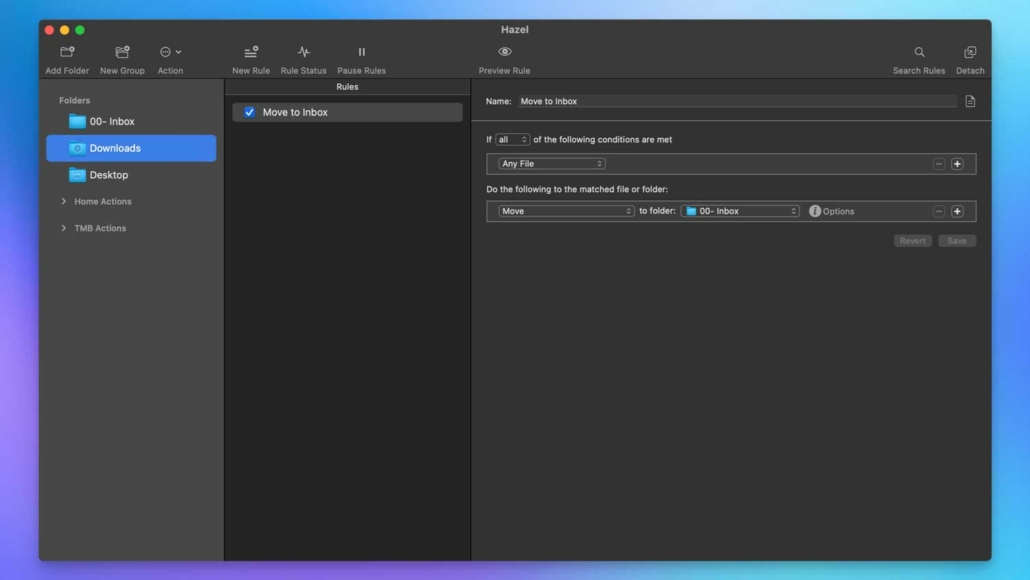
It’s really a testament to Hazel that I forget about it and how much it does for me. Hazel is a rock-solid menu bar app that specializes in watching folders and moving/renaming files it finds there. The nature of the app means that it is always watching/working in the background to keep my Mac tidy and to make sure files are how I like them.
Use Case Examples
- This is a holdover from my days of using multiple Macs, but a simple Hazel rule I have running is to move anything I download to an “inbox” folder in Google Drive. That way, the download is always available everywhere.
- I download PDF copies of all my important account statements; I have Hazel read the files and then rename them with the statement date and sort the file into the correct folder.
- When I export trip photos from Lightroom to my NAS, Hazel will upload those photos to Apple Photos and also sort the files into a folder named with the date and destination of the trip.
- When I download a specific report for work, Hazel recognizes the file and triggers a Keyboard Maestro macro to open and arrange the Excel file so I can review it.
- I have shortcuts that I run on my phone that save trigger files to iCloud. When Hazel sees one of those files, it runs an AppleScript that marks tasks off for me in Things.
More Resources to Help You Use Hazel
I need to give Hazel some more love on my YouTube Channel, but I have a playlist of videos where Hazel is featured. There are also some blog posts on my site about Hazel.
Who Should Use Hazel
I initially fell in love with Hazel when I was a teacher; managing an entire year’s worth of lesson plans and materials was a real chore until I started learning Hazel rules. I suspect any teacher or student would find the same benefit too.
Hazel is going to have the biggest impact on people who deal with a lot of local files on their computers. As someone who likes to have local copies of documents and does a lot of digital content creation, I find Hazel to be super handy.
Drafts
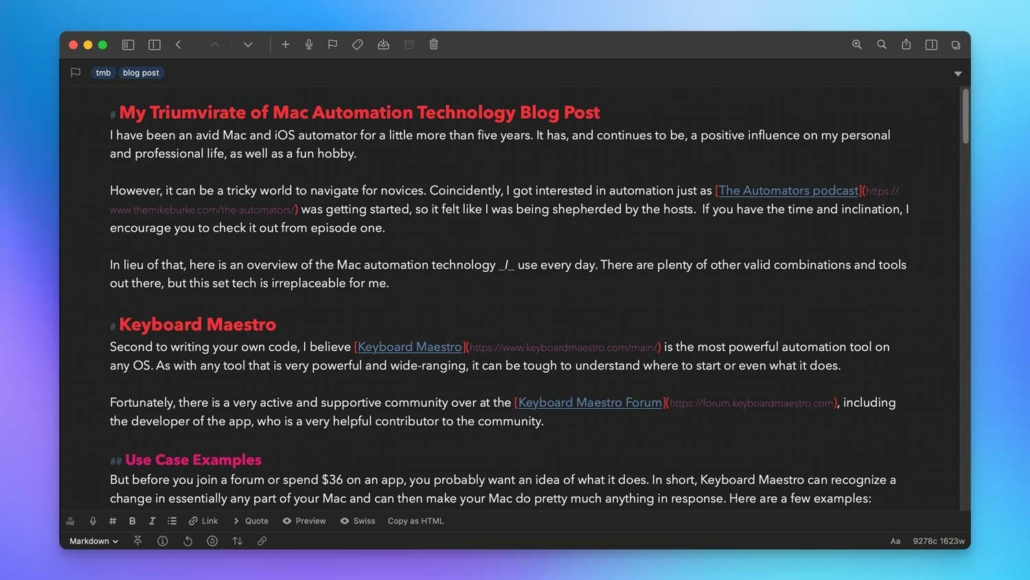
I am writing this post in Drafts right now; it is my ubiquitous tool for text on my Mac, iPad, and iPhone. With the exception of Messages, I don’t start typing text anywhere else.
My love for Drafts started as an easy-to-use, fast, and clean writing experience. It expanded even further once I started to wrap my mind around creating my own Drafts Actions, and at this point, I would rank Drafts as the tool whose absence would most rapidly devastate me.
Use Case Examples
- I have a shortcut look through my calendar every morning and make drafts in Drafts for taking notes for each meeting.
- I have an Action that I run at the end of the meeting to move the meeting notes to a Notion database and to make action items in Things for any of the commitments I made in the meeting.
- I keep a list of brain dump prompts in Drafts to help me during my weekly reviews. After I fill out the draft with all the things I have to do, I have an Action that tags all action items with the correct metadata tags and moves the action items to Things.
- I create/store project templates in Drafts and then use Actions to populate those templates and create projects in Things.
More Resources to Help You Use Drafts
I have an extensive Drafts playlist on my YouTube channel with tons of examples of how I use Drafts. Similarly, you can find many Drafts related blog posts too. There is also a fabulous community on the Drafts Forum.
Who Should Use Drafts
I think Drafts is great for anyone in the Apple ecosystem who regularly writes text with the goal of doing something with that text. That is a pretty wide net, but I think it is accurate. In my opinion, Drafts is truly the app most people don’t know they are missing.
Not Shortcuts?!
I am a big fan of shortcuts on iOS and iPadOS. I use it every day there because it is the best way I know of to automate and interact with Calendar data. However, I never use it on the Mac. Mainly because I already have what I need via the other tools on this list. I have plenty of videos and blog posts where I extol the virtues of Shortcuts; I am a fan! But on the Mac, I am much happier with the above apps.
Other Apps
There are tons of other cool things out there in the Mac automation space. I have experimented with many of them, but I just have not found a reason to stick with any of them.
Closure
I hope this post gives a little guidance to anyone exploring the awesome world of Mac automation. Please understand that this is the list that I have used thoroughly for many years, and it is what works for my brain and work. By all means, I hope you take inspiration from this post, but don’t feel like it is the only way to automate or be productive with your Mac.
In the comments, let me know what app you are using to automate your Mac or if anything on this list inspired you!


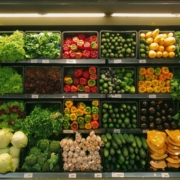
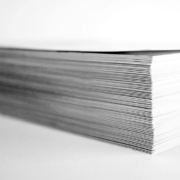
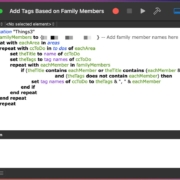







I’m an avid user of the same triumvirate and I found some useful information in this post. Many thanks for putting it together!
Thank you very much, Lou, for providing that feedback! It’s great to hear that even an experienced user like yourself is getting some value!